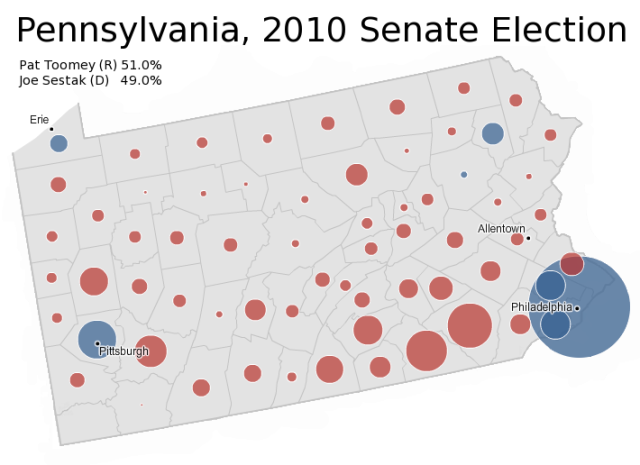This is a part of a series of posts analyzing the 2010 midterm elections. This post will analyze the Pennsylvania Senate election, in which Republican Pat Toomey won a narrow victory over Democrat Joe Sestak in a Democratic-leaning state.
More below.
Pennsylvania’s Political Structure
This map, modified from the New York Times website, provides a very useful visualization of the election. Democratic strength in Pennsylvania is very concentrated. The black vote helps Democrats win Philadelphia (by an enormous margin) and Pittsburgh (by a lesser one). Working-class whites in places like Erie, Scranton (which is the blue dot at the top-right corner of the map), and southwest Pennsylvania also generally vote Democratic. Or they used to, at any rate. Finally, wealthy whites in the suburbs of Philadelphia and the LeHigh Valley are also voting increasingly Democratic.
Republicans, on the other hand, generally win everywhere else. They are dominant in rural, conservative central Pennsylvania and the exurbs of the Philadelphia metropolis.
A strong Democrat will win all the areas of the Democratic base and then expand to win areas of the Republican coalition. Here is President Barack Obama, for instance:

Mr. Obama doesn’t just win the Democratic base, he does quite strongly in the exurbs of Philadelphia. Notice how much better he does in the Republican stronghold of Lancaster County (the biggest red circle in the first map) than Mr. Sestak does.
A strong Republican candidate, on the other hand, will win all the areas of the Republican base and then expand to win areas of the Democratic coalition. Republican Governor Tom Corbett, for instance, actually won Allegheny County, which Pittsburgh is located in.
Republican Senator Pat Toomey didn’t do so well. He won the Republican parts of Pennsylvania, but lost the Democratic parts of Pennsylvania. In normal elections, when this happens the result looks something like this:

This is the 2004 presidential election, in which Senator John Kerry barely won Pennsylvania. He did this without making any gains into Republican Pennsylvania. The Democratic parts of Pennsylvania just barely outnumber the Republican parts of Pennsylvania, which is why Pennsylvania is a Democratic-leaning state.
In 2010, however, Mr. Toomey – riding on a strong Republican wave – was able to overwhelm the Democratic parts of Pennsylvania. Mr. Toomey was able to squeeze enough blood out of the Republican exurbs and rural counties to win.
This is a fascinating result because it doesn’t happen that often. More often the result looks like 2004. The 2010 Pennsylvania Senate election thus constitutes a model of a Republican overwhelming Philadelphia and Pittsburgh without making many gains into Democratic territory.
Comparisons
Let’s compare Mr. Toomey’s performance with Mr. Obama’s performance:
As this image shows, there was a very uniform shift rightwards from 2008 to 2010; almost every county moved Republican by double-digits.
There are some interesting subtleties here. The Republican exurbs of Philadelphia, where Mr. Obama did so well, snapped back very strongly rightwards. On the other hand, Mr. Sestak actually did better in parts of southwest Pennsylvania – a Republican-trending region which was particularly uninspired by Mr. Obama.
There is an economic dimension to this. Republican Pat Toomey ran a campaign based on themes, such as free trade, which appealed more to well-off voters. Democrat Joe Sestak, on the other hand, ran a campaign based on more populist themes. We thus see Mr. Toomey doing particularly well in the rich parts of Pennsylvania, such as the LeHigh Valley or Lancaster County. Conversely, he actually did a bit worse than Senator John McCain in the poorest parts of the state: the Appalachian southwest and the city of Philadelphia.
Conclusions
Throughout the entire campaign, Democratic candidate Joe Sestak polled considerably behind Republican Pat Toomey. It was only at the end that he started catching up, as Pennsylvania’s Democratic nature asserted itself. However, Mr. Sestak couldn’t quite make it all the way; the Republican wave in 2010 was just too strong.
All in all, these results were very “normal.” This is in the sense that both candidates built very normal coalitions; neither did well in places Republicans or Democrats don’t usually do well in. The state itself shifted fairly uniformly from 2008. No one place behaved like an outlier (unlike the case with other states).
The 2010 Senate election thus constitutes a perfect example of just what a narrow Republican victory in Pennsylvania looks like.
–inoljt


1 comment